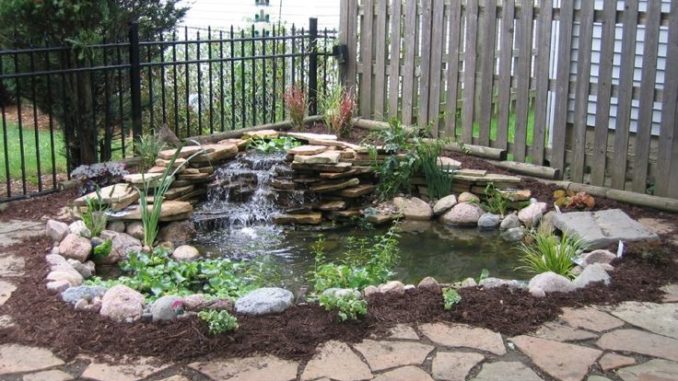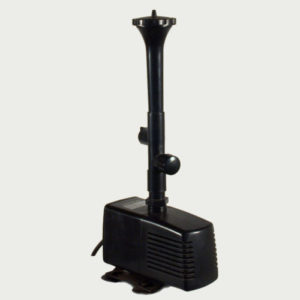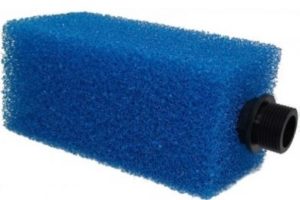
So your pond fish look like they might be struggling in the hot weather. There are usually signs you can watch out for that might tell you your fish are not coping with the heat very well such as:
- Fish may have gone off their food
- Fish may be very lethargic
- The fish may be seen to be breathing desperately at the surface of the water
- The fish may be rapidly breathing through the gills
- The fish may have lost its colour – often a sign of stress
Basically the warmer the water gets, the lesser amount of dissolved oxygen in the water there is. So what can we do to counter this in both the short term and the long term.

Add a Pond Pump and Run it 24-7 During Hot Weather
A pond pump does numerous positive things for your pond. Firstly it spits water into the air and then back into the pond – this process oxygenates your water. The water drags oxygen with it back into the water (the bubbles you see) thus aerating the water. I highly recommend adding to the pond pump a pre filter sponge (if the intake pipe features a screw in thread – Pondmaster and some BOYU pumps feature these threads.) The attachment simply screws into the intake pipe thread and is easily pulled off the pipe fitting to clean – very easy. The sponge does two things – filters your water and also creates a place for beneficial bacteria to thrive (if you do not wash the sponge directly under tap water) making your pond water healthier on two different levels.
Add an air stone / air bubbler.
Aeration is a great way to counteract warm water. When water becomes warm the amount of oxygen it holds decreases significantly. You might even notice your fish trying to breathe directly at the surface of the water in severe circumstances. The air stone / air pump throws much needed oxygen into an aquarium at all times creating healthier conditions, but particularly is useful during hot weather.
Use a Dechlorinator to Eliminate Chorine from Tap Water
You should be doing this anyway !! But during summer, water treatment plants put A LOT MORE chlorine in the tap water to keep our drinking water at healthy levels. So if you go and top up your pond during hot weather without using a dechlorinator, then you are at a very high risk of killing your fish. Please note: In Adelaide SA Water recommends we “double dose” dechlorinator both in aquariums or ponds.
Those of you saying I will just use rain water, be warned, rain water is extremely soft water that will make the pond water eventually become very acidic that will very quickly kill fish.

Keep feeding to an absolute minimum.
Due to the increased metabolism of fish in warmer water, they will want to eat more, therefore they will poo more. A very good rule of thumb is to ensure all foods are completely consumed within 30 seconds – in hot weather perhaps skip feeding alltogether – the fish will always eat algae and any insects that fly or grow in the water eg Mosquito larvae.
Check Your PH and Nitrate Levels
If your PH or Nitrate levels are out of whack then in the heat these will be contributing factors to fish stress / deaths. You can bring half a jar of pond water into our shop and we are happy to check levels for free.
Live Plants – The Good and the Bad
You will read everywhere how live plants are great for ponds – this is both true and false.
Plants are good for ponds for in the following ways:
- Plants do oxygenate the water during sunlight hours
- Plants do absorb nitrates created by your fish
- Plants provide shelter for fish to get away from predators eg birds or cats etc
- Plants create shade for ponds to help keep temperature down during sunlight hours
- Plants compete with algae growth keeping the pond looking nicer
However on the flip side, plants are not so good for ponds as soon as the sun goes down. So instead of photosynthesizing and creating oxygen, they now respire (much like we do) taking in oxygen which can have an effect of starving the fish with very reduced dissolved oxygen levels. This is why many fish are found dead in the very early hours of the morning.
To counter this you can do a couple of things. In extreme weather you can lift your pond plants just out of the water so the leaves levitate just above the water. Respiration takes place through the leaves and not through the roots, so by leaving just the pot and effectively the roots in the water with the leaves above, this should keep the plant happy and also the dissolved oxygen levels in the pond reasonable.
Other things that can be done include keeping a pond pump running overnight and/or an air pump with air stone can be added (we will go further in detail with these ideas later in the article.)
Adding ice to the Pond
A little word of warning – you should not dump a heap of ice in one go – sudden drop in temperature will completely stress the fish, fish prefer consistency. If you do choose this method, you would be best advised to freeze 3-4 containers of sealed water and continually rotate them during the heat of the day. If you do want to add ice directly, ensure it is dechlorinated and only use small amounts. Regularly check that the temperature does not go outside of required perimeters.
Review Density of Fish in a Pond
Do you simply have too may fish in the pond ? If you do have too many fish in there then the hot weather will usually catch you out. With the reduced dissolved oxygen levels in the pond, loaded up populations of fish in a pond will most certainly cause death or disease. So how many fish can we put in a pond ? There are a few factors to consider:
- Is there any filtration / aeration ?
- Is the pond in full sun, partial sun or full shade ?
- Does the pond have plants or not ?
- What size is the pond ?
- How deep is the pond ?
So starting at the basic level – I would suggest for a pond with no filter 1x 5cm fish per square foot of pond water.
However when you start to include things like pond pumps or aeration you can probably increase this to 2 or 3 5cm fish per square foot.
